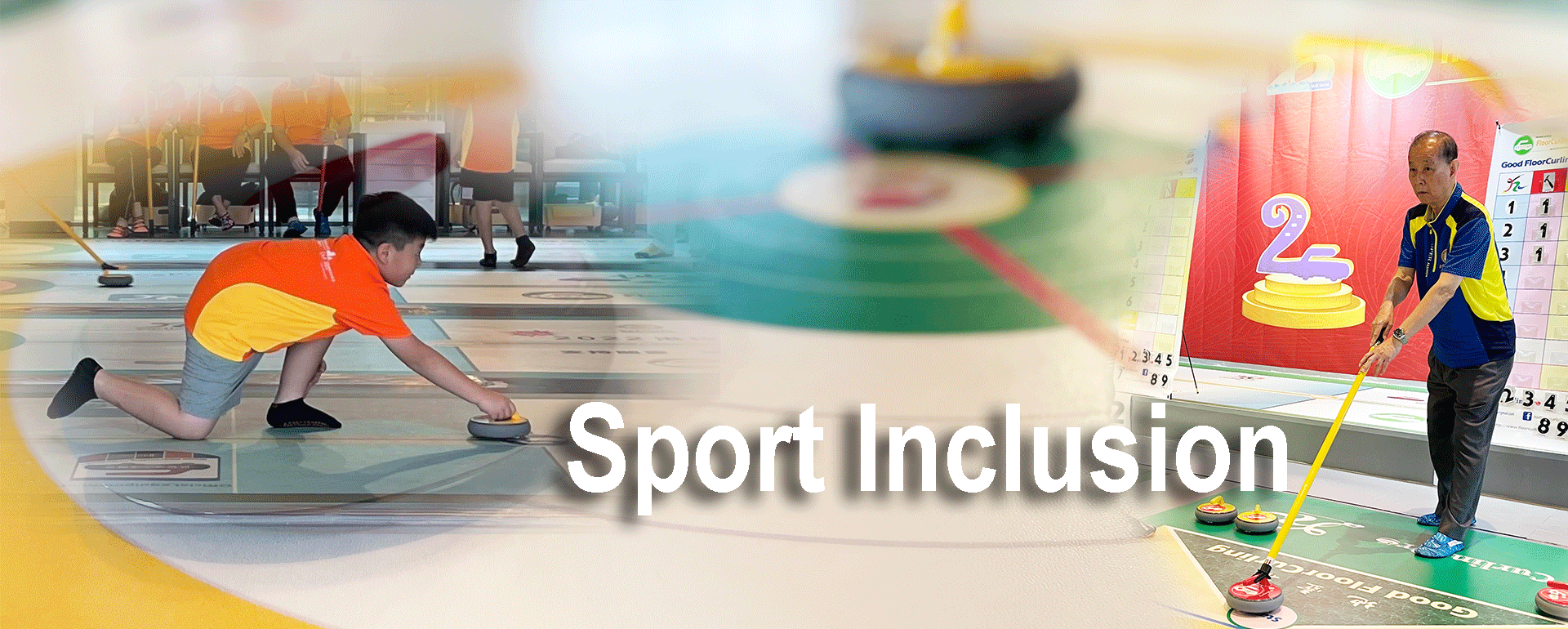“Three-Actions-for-All” lays the foundation for sport inclusion in FloorCurling. Inclusive sport provides opportunities to people of different ages, gender, or abilities, to play and compete against each other. How does FloorCurling achieve sport inclusion through “Three-Actions-for-All”?

How to achieve “For-All”?
- Simple rules that can easily be mastered so that participants can quickly set ready for competition.
- Accepts different delivery styles: squat, on a chair by hand, in a wheelchair with delivery stick or slider, sit on the floor, stand using a delivery stick.
- Three delivery start points allows people of different abilities/ ages to compete on the same lane.
- Inclusive team formation is a natural and common phenomenon in floorcurling. Teams could be composed of abled or disabled, young or old, men or women. Inclusive teams can compete against each other.
- Equipment is portable and easy to set up. The four major pieces of equipment include the rocks, the lane, the brush/pusher and the scoring board.
- Venue requirement is a flat surface which can accommodate the floorcurling lane.
- Regular competitions offer a driving force for floorcurlers to practise, improve and advance.
- Concerted vision towards inclusion for participants and supporters alike.
What are the “Three Actions”?
- Work Hard: Master the technical skills including line and weight.
- Work Smart: Approach the game strategically to outwit your opponent.
- Work Together: Aspire to team spirit with passion and a positive attitude.
Where does FloorCurling stand in social inclusion?
FloorCurling is dedicated to the sustainable development of inclusion through sport. It has set three United Nations SDG (Sustainable Development Goals) World Records supporting Goal 10 — Reduced Inequalities:
- The most inclusive FloorCurling activity consisting of people with 10 types of disabilities (25 and 26 June 2022)
- First “Hosting newly emerged sport concurrently in two cities” (29 October 2022)
- First “Inter-city FloorCurling online championship” (29 October 2022)
In the following two social inclusion models/ frameworks, FloorCurling stands in the forefront:
- Simplican’s (2015) Model of social inclusion advocated that social inclusion is not only a personal issue, but also an issue of civil rights, equality, and economics. The model focuses on two domains: interpersonal relationships and community participation. FloorCurling fares well under the interpersonal relationships domain, engaging a diverse group of people taking initiatives to practice and join competitions year round. International exchange through training and competitions has resumed in the post-COVID period. FloorCurling also fares well under the community participation domain, with the non-contact sport of FloorCurling organised in a mainstream setting with a diverse group of people immersed in the spirit of inclusion.
- De Luca’s (2013) Framework of inclusivity outlined a continuum with four conceptions of inclusivity: normative, integrative, dialogical and transgressive. Development of FloorCurling is approaching the Transgressive conception featuring naturalness in diversity with no dominant group. People of different ages, gender and abilities come to play together and compete against each other. With the multiplicity in the delivery styles and the three delivery distances to accommodate different abilities, floorcurling emphasises the sports ability of the players instead of their disabilities.
There is no universal or standardised solution for fostering inclusion through sport. FloorCurling, however, is one such solution. It will be great if other inclusive sports could be developed providing more choices for people to participate. A World Federation of Inclusive Sports could then be established to facilitate experience sharing and to form a united front towards inclusion.
On a macro scale, sports can serve as a tool to foster inclusion in the society at large. The United Nations recognizes the role of sports in its Transforming our world: the 2030 agenda for sustainable development — “We recognize the growing contribution of sport to the realization of development and peace in its promotion of tolerance and respect and the contributions it makes to the empowerment of women and of young people, individuals and communities as well as health, education and social inclusion objectives.” (United Nations, 2015). The Hong Kong Government is also committed to social inclusion for people with disabilities, ethnic minorities, new arrivals from the Mainland and the underprivileged, in regard to education, livelihood and community resources. (Hong Kong Government, 2022) Perhaps there is a lot of room for development.

